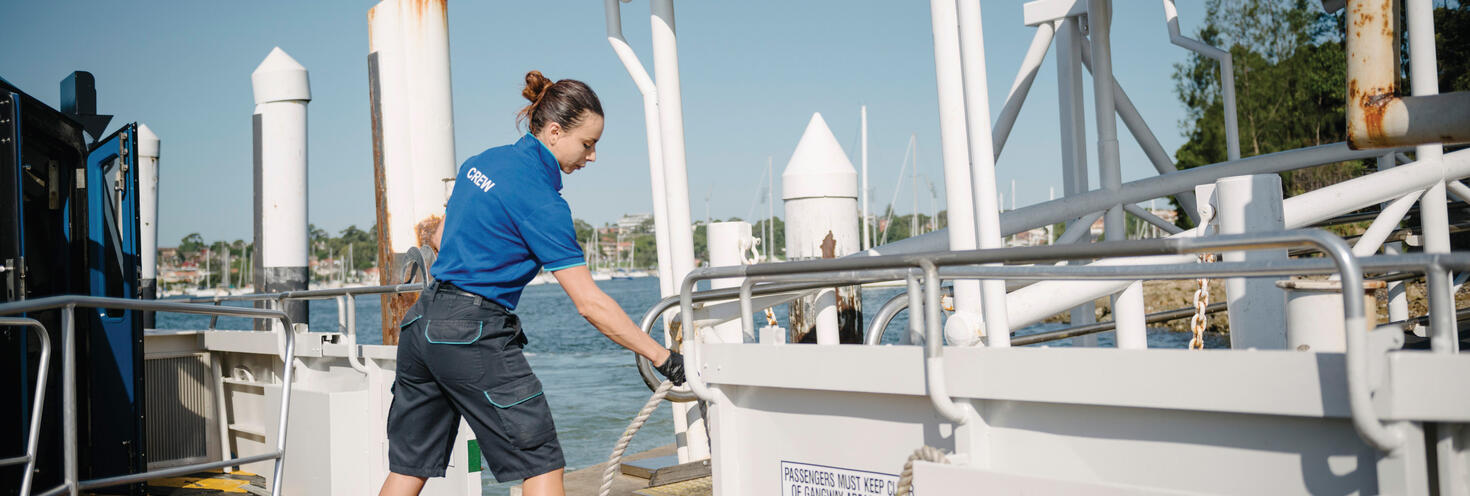Safety when travelling by ferry

photo credit: Gavin Yowett 2017
When using public transport, stay alert and don't be distracted by your mobile phone.
Allow plenty of travel time and slow down to avoid slips and falls.
There are many safety considerations when travelling by water.
Follow these guidelines for a safe trip on ferries in NSW.
If you have accessibility requirements, read through the accessible travel information when planning your trip.
- When waiting for your service and for the ferry to berth, wait a safe distance away from the water’s edge. Follow instructions given by the ferry crew.
- If you have a mobility aid or pram, ensure it is secured and parked sideways, rather than facing the water.
- If you see someone in the water requiring assistance, use the lifebuoy on the wharf. Immediately alert the crew if available and use the Emergency Help Point.
- Allow all passengers to get off the ferry before you get on. The crew holding the gangway will let you know when it is safe to board.
- Be careful as you walk over the gangway, hold onto the handrail and watch your footing. If you need assistance, please ask the ferry crew.
- When on board, take a seat if one is available or hold onto a handrail.
- Do not sit on the bow or side of the vessel.
- Do not lean out the windows or stand on the seats.
- Ensure luggage, bags and personal items are stowed correctly and are not blocking the aisle.
- Watch your step when using the stairs and hold onto the handrails as the ferry can move suddenly.
- When waiting to disembark, stand behind the yellow area on the vessels and follow instructions from the ferry crew.
- Speak with the crew if travelling with a bike or surfboard. They will advise if you can bring it onto the ferry and where to stow it.
- All ferries have life jackets. Please use as directed by staff.
If you are concerned about your safety or the safety of others, or in an emergency, please:
- Move away from danger, if possible.
- Alert the crew. On the Manly Ferries use the Emergency Help Point on board.
- Listen for instructions from the crew
- People with disabilities and their carers are given priority boarding. Read the accessible ferry travel information when planning your trip.
- If travelling with a pram and young children, take your child out, fold up the pram and assist your child onto the ferry.
- If you require assistance, make yourself known to a staff member on the wharf.
- If the wharf is unstaffed, please wait for your service in a safe place away from the wharf edge.
- The ferry crew will assist you to board. Advise them of your destination so they are ready to assist when you need to disembark.
All wharves are fitted with CCTV cameras and Emergency Help Points.
Police and transport officers patrol ferries and wharves.
If you need immediate help, contact the police on 000, talk to the ferry crew or use an Emergency Help Point.
If you see something, say something
Please report security incidents, unattended items or suspicious behaviour. You can help us respond to any immediate problems, making it safer for everyone.
Call 000 or contact the National Security Hotline on 1800 123 400.
All wharves are fitted with CCTV cameras and Emergency Help Points.
Some CCTV cameras are only used to monitor and do not record footage. If footage has been recorded, you can request access to this footage.
If you press an Emergency Help Point on any wharf, you're visible on live CCTV and can get assistance from a trained operator.
A security control centre operates 24 hours a day, 7 days a week, with communication links to transport officers, police and emergency services.
If you are not feeling well or you see someone who looks like they need help, use the Emergency Help Point or speak to transport staff and the ferry crew where available and they will arrange medical assistance.
Please do not board the ferry if you're not feeling well at the wharf. We will be able to get help to you much quicker at the wharf.
In an emergency, call 000.